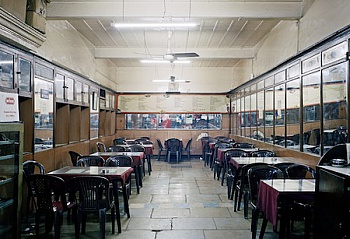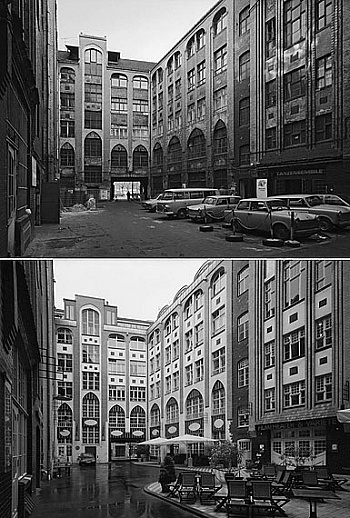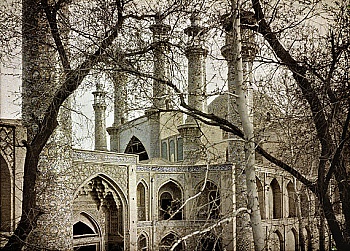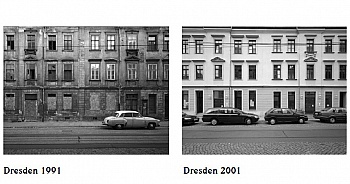Stefan Koppelkamm #Photographe
Stefan Koppelkamm est né en 1952.
Exposition Mois de la photo 2012 : Exposition de Stefan KoppelKamm à la Goethe Institut de Paris Exposition Ortszeit Local Time - Stefan Koppelkamm Exposition A New View of Architectural Photography from the National Museums in Berlin Exposition Ortszeit Local Time. Temporalités allemandes - Stefan Koppelkamm Modifier l'image
 Le photographe berlinois Stefan Koppelkamm s’est toujours intéressé dans son œuvre photographique, à ce qu’il y a derrière les images. Au-delà de leur fonction et de leur esthétique, il s’intéresse aux traces visibles et invisibles, aux marques et empreintes que l’homme laisse sur les choses et l’environnement.
Dans « Boire, manger, parler », il associe le visuel au sonore : comment entendons-nous les diverses villes, comment se transforme notre cadre acoustique tout au long de l’année ? En fréquentant les restaurants et les cafés, il s’est demandé si le mélange de voix et de bruits est identique partout, ou si nous pouvions deviner à l’oreille, dans quel lieu géographique, social nous nous trouvons.
...
Le photographe berlinois Stefan Koppelkamm s’est toujours intéressé dans son œuvre photographique, à ce qu’il y a derrière les images. Au-delà de leur fonction et de leur esthétique, il s’intéresse aux traces visibles et invisibles, aux marques et empreintes que l’homme laisse sur les choses et l’environnement.
Dans « Boire, manger, parler », il associe le visuel au sonore : comment entendons-nous les diverses villes, comment se transforme notre cadre acoustique tout au long de l’année ? En fréquentant les restaurants et les cafés, il s’est demandé si le mélange de voix et de bruits est identique partout, ou si nous pouvions deviner à l’oreille, dans quel lieu géographique, social nous nous trouvons.
... Photographies 1990 - 2004
Part of the Fourth European Month of Photography Berlin 2010
until 21th November 2010
Ortszeit Local Time
Photographic exhibition at the Museum for Communication Berlin documents the speed of change after the fall of ‘the Wall’
When Stefan Koppelkamm travelled through East Germany in 1990, he wanted to document the state of urban and countryside situations which he was sure would disappear before long. He was not interested in new developments or the traces of advancing capitalism. Instead, he focused his eyes and camera on looking back, on the Germany of his parents and grandparents and what it must have looked like in their time. As an attentive observer, he sought out the ordinariness of house facades and street fronts, for example. Fourteen years later, he went back ...
Photographies 1990 - 2004
Part of the Fourth European Month of Photography Berlin 2010
until 21th November 2010
Ortszeit Local Time
Photographic exhibition at the Museum for Communication Berlin documents the speed of change after the fall of ‘the Wall’
When Stefan Koppelkamm travelled through East Germany in 1990, he wanted to document the state of urban and countryside situations which he was sure would disappear before long. He was not interested in new developments or the traces of advancing capitalism. Instead, he focused his eyes and camera on looking back, on the Germany of his parents and grandparents and what it must have looked like in their time. As an attentive observer, he sought out the ordinariness of house facades and street fronts, for example. Fourteen years later, he went back ... The Art Library is reopening its newly reconstructed Kaisersaal (Emperor's Hall) at the Museum of Photography with a show of hidden treasures of architectural photography from the collections of the National Museums. Nearly all of the individual museums have acquired since some 150 years photographs. The genre of architectural photography is especially prominent represented. It was collected for the purpose of documenting ethnological and archeological expeditions, to archive architectural monuments or as an art form in its own right. An impressive panorama of the most diverse architectural motifs unfolds, ranging from the beginnings of photography to today: to mention but a few, there are images of bamboo huts from the Ethnological Museum, of temples from the Egyptian Museum, of Indian mosques from the Museum of Asian A...
The Art Library is reopening its newly reconstructed Kaisersaal (Emperor's Hall) at the Museum of Photography with a show of hidden treasures of architectural photography from the collections of the National Museums. Nearly all of the individual museums have acquired since some 150 years photographs. The genre of architectural photography is especially prominent represented. It was collected for the purpose of documenting ethnological and archeological expeditions, to archive architectural monuments or as an art form in its own right. An impressive panorama of the most diverse architectural motifs unfolds, ranging from the beginnings of photography to today: to mention but a few, there are images of bamboo huts from the Ethnological Museum, of temples from the Egyptian Museum, of Indian mosques from the Museum of Asian A... Le photographe berlinois Stefan Koppelkamm s’était promené après la chute du mur à travers l’ex-Berlin-Est et l’ex-RDA pour fixer un état des lieux.
Ces images montrent encore les vieilles blessures de la guerre passée depuis longtemps et un délabrement triste et révoltant du à la négligence d’une société, mais aussi le temps arrêté sur une réalité figée.
Quelques années plus tard Koppelkamm est retourné sur les mêmes lieux et y a trouvé des transformations qui sont le reflet du changement de la société vu à l’extérieur, seulement peu de transformations urbanistiques y sont perceptibles.
Il s’agit...
Le photographe berlinois Stefan Koppelkamm s’était promené après la chute du mur à travers l’ex-Berlin-Est et l’ex-RDA pour fixer un état des lieux.
Ces images montrent encore les vieilles blessures de la guerre passée depuis longtemps et un délabrement triste et révoltant du à la négligence d’une société, mais aussi le temps arrêté sur une réalité figée.
Quelques années plus tard Koppelkamm est retourné sur les mêmes lieux et y a trouvé des transformations qui sont le reflet du changement de la société vu à l’extérieur, seulement peu de transformations urbanistiques y sont perceptibles.
Il s’agit...